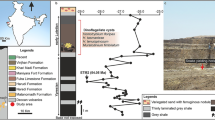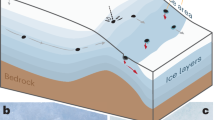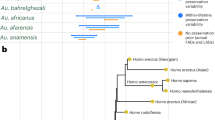Abstract
The transition from the Middle to the Upper Palaeolithic, approximately 40,000–35,000 radiocarbon years ago, marks a turning point in the history of human evolution in Europe. Many changes in the archaeological and fossil record at this time have been associated with the appearance of anatomically modern humans1,2. Before this transition, the Neanderthals roamed the continent, but their remains have not been found in the northernmost part of Eurasia. It is generally believed that this vast region was not colonized by humans until the final stage of the last Ice Age some 13,000–14,000 years ago3,4. Here we report the discovery of traces of human occupation nearly 40,000 years old at Mamontovaya Kurya, a Palaeolithic site situated in the European part of the Russian Arctic. At this site we have uncovered stone artefacts, animal bones and a mammoth tusk with human-made marks from strata covered by thick Quaternary deposits. This is the oldest documented evidence for human presence at this high latitude; it implies that either the Neanderthals expanded much further north than previously thought or that modern humans were present in the Arctic only a few thousand years after their first appearance in Europe.
This is a preview of subscription content, access via your institution
Access options
Subscribe to this journal
Receive 51 print issues and online access
$199.00 per year
only $3.90 per issue
Buy this article
- Purchase on Springer Link
- Instant access to full article PDF
Prices may be subject to local taxes which are calculated during checkout




Similar content being viewed by others
References
Gamble, C. Paleolithic Societies of Europe 268–426 (Cambridge Univ. Press, Cambridge, 1999).
Stringer, C. B. & Mackie, R. African Exodus: the Origin of Modern Humanity 84–111 (Cape, London, 1996).
Hoffecker, J. F., Powers, W. R. & Goebel, T. The colonization of the Beringia and the peopling of the New World. Science 259, 46–53 (1993).
Mochanov, Yu. A. Initial Settling of the Territory of North-Eastern Asia (Nauka, Novosibirsk, 1977) (in Russian).
Allsworth-Jones, P. The Szeletian 83–198 (Clarendon, Oxford, 1986).
Kolosov, Yu. G. Mousterian Sites of the Belogorsk Area, Crimea (Nauka, Kiev, 1983) (in Russian).
Praslov, N. D. & Rogachev, A. N. (eds) Paleolit Kostenkovsko–Borschevskogo raiona na Donu 1879–1979 (Palaeolithic of the Kostenki–Borshevo Area on the Don River) 16–66 (Nauka, Leningrad, 1982) (in Russian).
Halvorsen, L. S. Palaeovegetation and Environment during Weichselian Stadials and Interstadials at Mamontovaya Kurja and Sokolova in the Pechora Basin, Northern Russia. Thesis, Univ. Bergen (2000).
Van Andel, T. H. & Tzedakis, P. C. Palaeolithic landscapes of Europe and environs, 150,000–25,000 years ago: An overview. Quat. Sci. Rev. 15, 481–500 (1996).
Svendsen, J. I. et al. Maximum extent of the Eurasian ice sheet in the Barents and Kara Sea region during the Weichselian. Boreas 28, 234–242 (1999).
Astakhov, V. I. et al. Marginal formations of the last Kara and Barents ice shelves in northern European Russia. Boreas 28, 23–45 (1999).
Mangerud, J., Svendsen, J. I. & Astakhov, V. I. Age and extent of the Barents and Kara ice sheets in Northern Russia. Boreas 28, 46–80 (1999).
Powers, W. R. in Humans at the End of the Ice Age—The Archaeology of the Pleistocene–Holocene Transition (eds Straus, L. G., Eriksen, B. V., Erlandson, J. M. & Yesner, D. R.) 229–253 (Plenum, New York, 1996).
Kanivets, V. I. The Paleolithic of the Extreme North-East of Europe (Nauka, Moscow, 1976) (in Russian).
Pavlov, P.-Yu. The excavation of Byzovaya Upper Palaeolithic site in 1983–1985 in Pamiatniki materialnoj kultyury na Evropeiskom severo-vostoke 7–16 (Russian Acad. Sci., Syktyvkar, 1986) (in Russian).
Pavlov, P. Yu The Palaeolithic Archaeology of the Komi Republic 44–91 (DiK, Moskva, 1996) (in Russian).
Pavlov, P. Yu. & Indrelid, S. Initial settling of North-Eastern Europe. Bull. Inst. Biol., Syktyvkar 2, 24–26 (1999)
Anikovich, M. V. Early Upper Palaeolithic in Eastern Europe (AN SSSR, St Petersburg, 1991) (in Russian).
Straus, L. G. Age of Modern Europeans. Nature 342, 476–477 (1989).
Smith, F. H., Trinkhaus, E., Pettitt, P. B., Karavanic, I. & Paunovic, M. Direct radiocarbon dates for Vindija G1 and Velika Pecina Late Pleistocene hominid remains. Proc. Natl Acad. Sci. USA 96,12281–12286 (1999).
Bader, O. N. Sungir–Upper Palaeolithic Site (Nauka, Moskva, 1978) (in Russian).
Sinitsyn, A. A. & Praslov, N. D. Radiocarbon chronology of the Paleolithic of Eastern Europe and Northern Asia. Problems Perspectives (Russian Acad. Sci., St Petersburg, 21–66 1997).
Bocquet-Appel, J.-P. & Demars, P. Y. Neanderthal contraction and northern human colonization of Europe. Antiquity 74, 544–552 (2000).
Straus, L. G., Bicho, N. & Winegardner, A. C. The Upper Palaeolithic settlement of Iberia: first-generation maps. Antiquity 74, 553–566 (2000).
Ovchinnikov, I. V. et al. Molecular analysis of Neanderthal DNA from the northern Caucasus. Nature 404, 490–493 (2000).
d'Ericco, F., Zilhao, J., Julien, M., Baffier, D. & Pelegrin, J. Neanderthal acculturation in Western Europe? A critical review of evidence and its interpretation. Curr. Anthrop. 39 (Suppl.), 1–44 (1998).
Bar-Yosef, O. in Neanderthals and Modern Humans in Western Asia (eds Akazawa, T., Aoki, K. & Bar-Yosef, O.) 39–56 (Plenum, New York, 1998).
Acknowledgements
This work is a contribution to the Russian–Norwegian research project Paleo Environment and Climate History of the Russian Arctic (PECHORA), which forms part of the European Science Foundation Program Quaternary Environment of the Eurasian North (QUEEN). We thank E. Giria, Institute of History of the Material Culture, St Petersburg University, for carrying out microscopic analysis of the marks on the mammoth tusk. We thank J. Mangerud for his comments on this manuscript and for discussions. The bond material was identified by I. Kuzmina and D. Ponomarev. The drawing of the tusk and the stone artefacts were done by N. Pavlov and the figures by E. Bjørseth. We thank the Norwegian Research Council for financial support.
Author information
Authors and Affiliations
Corresponding author
Rights and permissions
About this article
Cite this article
Pavlov, P., Svendsen, J. & Indrelid, S. Human presence in the European Arctic nearly 40,000 years ago. Nature 413, 64–67 (2001). https://doi.org/10.1038/35092552
Received:
Accepted:
Issue Date:
DOI: https://doi.org/10.1038/35092552
This article is cited by
-
Defining the ‘generalist specialist’ niche for Pleistocene Homo sapiens
Nature Human Behaviour (2018)
-
Sequential Incisions on a Cave Bear Bone from the Middle Paleolithic of Pešturina Cave, Serbia
Journal of Archaeological Method and Theory (2018)
-
Siberia and neighboring regions in the Last Glacial Maximum: did people occupy northern Eurasia at that time?
Archaeological and Anthropological Sciences (2018)
-
Deglaciation and Human Colonization of Northern Europe
Journal of World Prehistory (2014)
-
A Tale of Two Migrations: Reconciling Recent Biological and Archaeological Evidence for the Pleistocene Peopling of the Americas
Journal of Archaeological Research (2011)
Comments
By submitting a comment you agree to abide by our Terms and Community Guidelines. If you find something abusive or that does not comply with our terms or guidelines please flag it as inappropriate.



